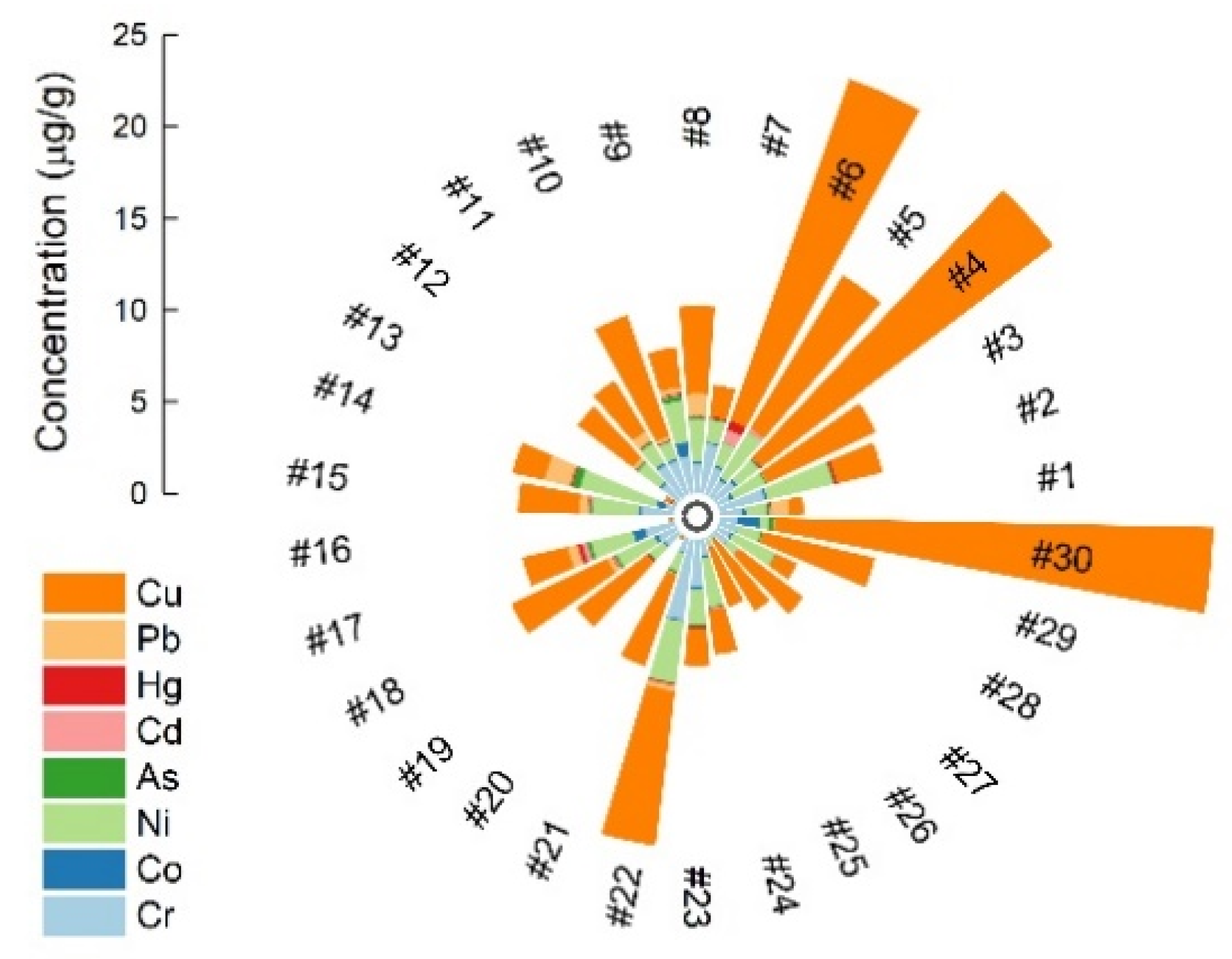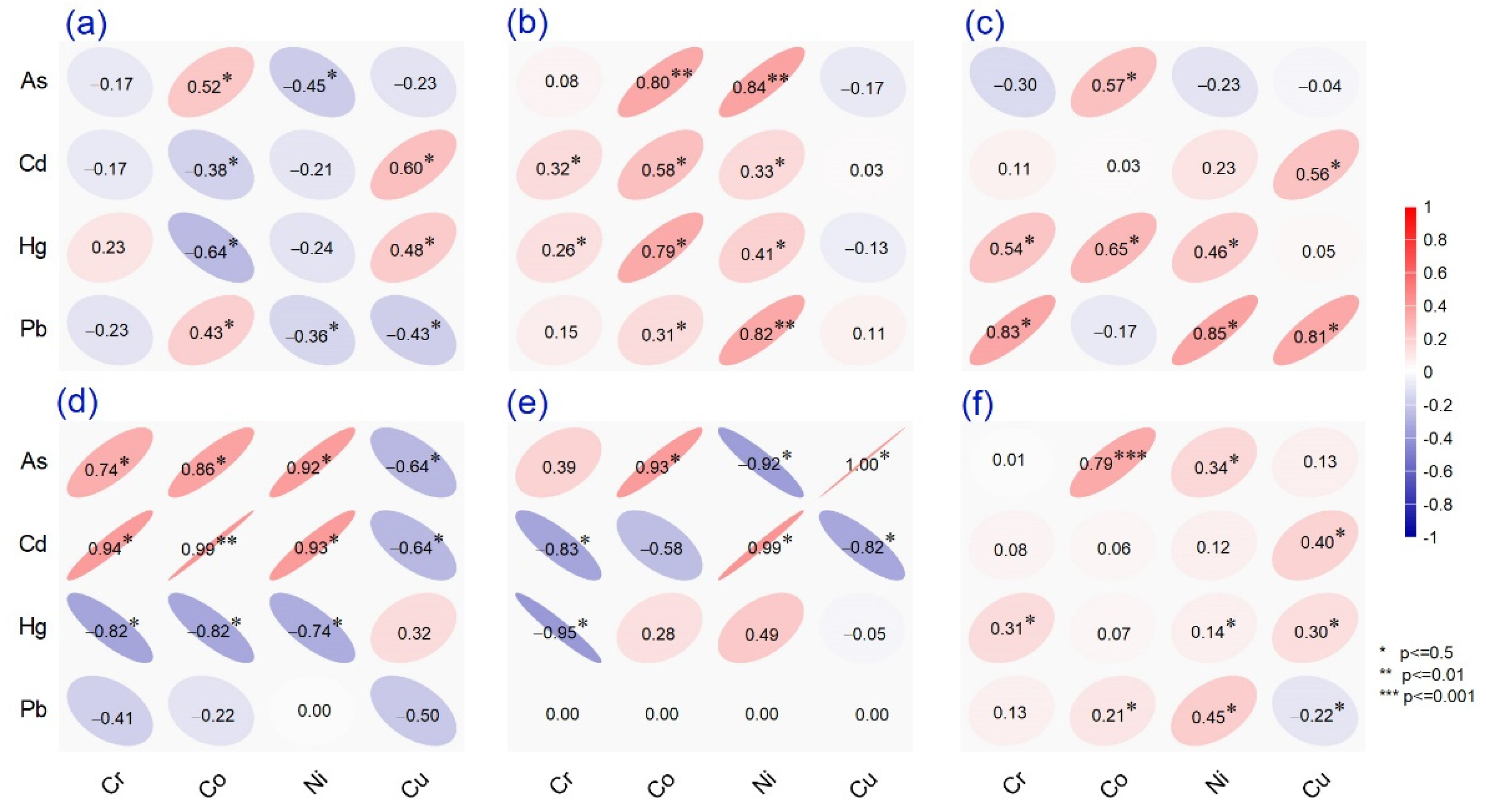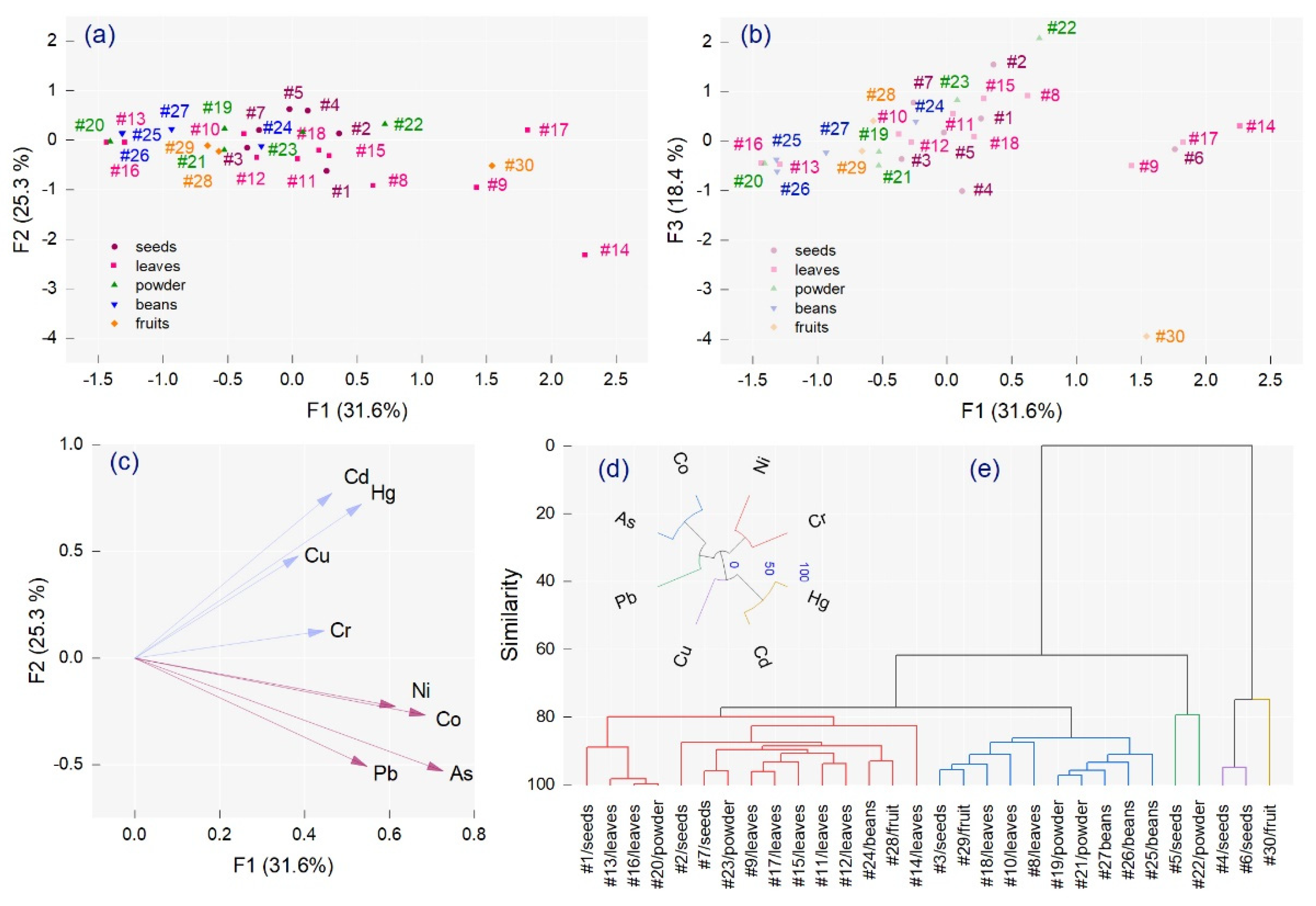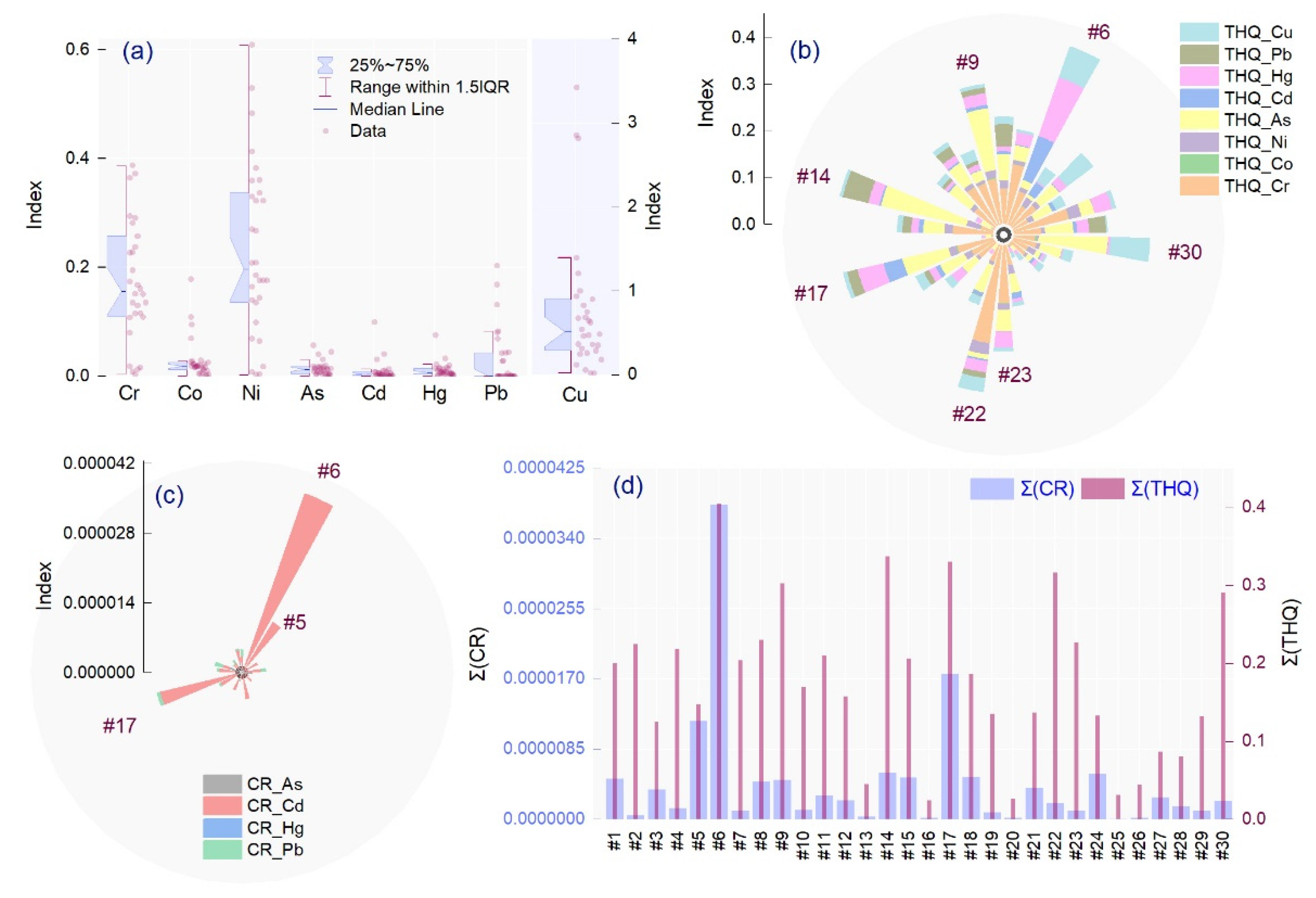ICP-MS Assessment of Essential and Toxic Trace Elements in Foodstuffs with Different Geographic Origins Available in Romanian Supermarkets
Abstract
:1. Introduction
2. Results and Discussion
2.1. Validation of Analytical Methods and Summary Statistics
2.2. Concentration of Minor Elements in Different Spices
2.3. Potentially Toxic Trace Elements
2.4. Correlation Analysis
2.5. Exposure Assessment of Trace Elements and Health Risk Characterization
3. Materials and Methods
3.1. Sample Preparation and Digestion
3.2. Instrumentation
3.3. Chemical Reagents and Material Standards
3.4. Quality Assurance
3.5. Statistical Analysis
4. Conclusions
Author Contributions
Funding
Institutional Review Board Statement
Informed Consent Statement
Data Availability Statement
Acknowledgments
Conflicts of Interest
References
- Potortì, A.G.; Bua, G.D.; Turco, V.L.; Tekaya, A.B.; Beltifa, A.; Mansour, H.B.; Di Bella, G. Major, minor and trace element concentrations in spices and aromatic herbs from Sicily (Italy) and Mahdia (Tunisia) by ICP-MS and multivariate analysis. Food Chem. 2020, 313, 126094. [Google Scholar] [CrossRef] [PubMed]
- Galvin-King, P.; Haughey, S.A.; Elliott, C.T. Herb and spice fraud; the drivers, challenges and detection. Food Control 2018, 88, 85–97. [Google Scholar] [CrossRef] [Green Version]
- C.B.I. Ministry of Foreign Affairs Market Intelligence. Trends: Spices and Herbs in Europe. 2016. Available online: https://www.cbi.eu/sites/default/files/market_information/researches/trends-europe-spices-herbs-2016_0.pdf (accessed on 8 September 2017).
- Swain, S.; Rautray, T.R. Estimation of trace elements, antioxidants, and antibacterial agents of regularly consumed Indian medicinal plants. Biol. Trace Elem. Res. 2021, 199, 1185–1193. [Google Scholar] [CrossRef]
- Bouaoud, K.; Menadi, N.; Zairi, M.; Bouazza, S.; Bekhadda, H.; Meraou, A.; Demmouche, A. Evaluation of the curative role, Anti-inflammatory and anti-oxidative activity of some dietary spices on carrageenan induced paw edema in albino Wistar rats. J. Drug Deliv. Ther. 2020, 10, 90–96. [Google Scholar] [CrossRef]
- Chakraborty, M.; Afrin, T.; Munshi, S.K. Microbiological quality and antimicrobial potential of extracts of different spices. Food Res. 2020, 4, 375–379. [Google Scholar] [CrossRef]
- Sanlier, N.; Gencer, F. Role of spices in the treatment of diabetes mellitus: A minireview. Trends Food Sci. Technol. 2020, 99, 441–449. [Google Scholar] [CrossRef]
- Xu, B.; Ganesan, K.; Mickymaray, S.; Alfaiz, F.A.; Thatchinamoorthi, R.; Al Aboody, M.S. Immunomodulatory and antineoplastic efficacy of common spices and their connection with phenolic antioxidants. BCHD 2020, 3, 15–31. [Google Scholar] [CrossRef] [Green Version]
- Sokamte, T.A.; Mbougueng, P.D.; Tatsadjieu, N.L.; Sachindra, N.M. Phenolic compounds characterization and antioxidant activities of selected spices from Cameroon. S. Afr. J. Bot. 2019, 121, 7–15. [Google Scholar] [CrossRef]
- Reinholds, I.; Bartkevics, V.; Silvis, I.C.; van Ruth, S.M.; Esslinger, S. Analytical techniques combined with chemometrics for authentication and determination of contaminants in condiments: A review. J. Food Compost. Anal. 2015, 44, 56–72. [Google Scholar] [CrossRef]
- Caldeirão, L.; Sousa, J.; Nunes, L.C.; Godoy, H.T.; Fernandes, J.O.; Cunha, S.C. Herbs and herbal infusions: Determination of natural contaminants (mycotoxins and trace elements) and evaluation of their exposure. Food Res. Int. 2021, 144, 110322. [Google Scholar] [CrossRef] [PubMed]
- Tan, S.H.; Karri, V.; Tay, N.W.R.; Chang, K.H.; Ah, H.Y.; Ng, P.Q.; Candasamy, M. Emerging pathways to neurodegeneration: Dissecting the critical molecular mechanisms in Alzheimer’s disease, Parkinson’s disease. Biomed. Pharmacother. 2019, 111, 765–777. [Google Scholar] [CrossRef]
- Commission Regulation, 2006. Commission Regulation (E.C.) No. 1881/2006 of 19 December 2006 setting maximum levels for certain contaminants in foodstuffs. Off. J. Eur. Union 2006, 49, 5–24. [Google Scholar]
- WHO, World Health Organization. WHO Guidelines for Assessing Quality of Herbal Medicines with Reference to Contaminants and Residues. WHO Library Cataloguing-in-Publication Data. World Health Organization, Geneva. 2007. Available online: http://apps.who.int/medicinedocs/index/assoc/s14878e/s14878e.pdf (accessed on 12 March 2021).
- EFSA Panel on Contaminants in the Food Chain (CONTAM). Scientific Opinion on lead in food. EFSA J. 2010, 8, 1570–1717. [Google Scholar]
- Costagliola, A.; Roperto, F.; Benedetto, D.; Anastasio, A.; Marrone, R.; Perillo, A.; Paciello, O. Outbreak of fatal nitrate toxicosis associated with consumption of fennels (Foeniculum vulgare) in cattle farmed in Campania region (southern Italy). Environ. Sci. Pollut. Res. 2014, 21, 6252–6257. [Google Scholar] [CrossRef]
- Khan, N.; Choi, J.Y.; Nho, E.Y.; Jamila, N.; Habte, G.; Hong, J.H.; Kim, K.S. Determination of minor and trace elements in aromatic spices by microwave assisted digestion and inductively coupled plasma-mass spectrometry. Food Chem. 2014, 158, 200–206. [Google Scholar] [CrossRef]
- Hondrogiannis, E.; Peterson, K.; Zapf, C.M.; Roy, W.; Blackney, B.; Dailey, K. The use of wavelength dispersive X-ray fluorescence and discriminant analysis in the identification of the elemental composition of cumin samples and the determination of the country of origin. Food Chem. 2012, 135, 2825–2831. [Google Scholar] [CrossRef] [PubMed]
- Melnyk, J.P.; Wang, S.; Marcone, M.F. Chemical and biological properties of the World’s most expensive spice: Saffron. Food Res. Int. 2010, 43, 1981–1989. [Google Scholar] [CrossRef]
- Hondrogiannis, E.M.; Ehrlinger, E.; Poplaski, A.; Lisle, M. Use of laser ablation-inductively coupled plasma-time of flight-mass spectrometry to identify the elemental composition of vanilla and determine the geographic origin by discriminant function analysis. J. Agric. Food Chem. 2013, 61, 11332–11337. [Google Scholar] [CrossRef]
- De La Calle, I.; Costas, M.; Cabaleiro, N.; Lavilla, I.; Bendicho, C. Fast method for multielemental analysis of plants and discrimination according to the anatomical part by total reflection X-ray fluorescence spectrometry. Food Chem. 2013, 138, 234–241. [Google Scholar] [CrossRef]
- Frieden, E. New perspectives on the essential trace elements. J. Chem. Educ. 1985, 62, 917–923. [Google Scholar] [CrossRef]
- World Health Organization. Trace Elements in Human Nutrition and Health; World Health Organization: Geneva, Switzerland, 1996. [Google Scholar]
- Rehman, M.; Liu, L.; Wang, Q.; Saleem, M.H.; Bashir, S.; Ullah, S.; Peng, D. Copper environmental toxicology, recent advances, and future outlook: A review. Environ. Sci. Pollut. Res. 2019, 26, 18003–18016. [Google Scholar] [CrossRef]
- Zhang, Y.; Dong, Z.; Yang, H.; Liang, X.; Zhang, S.; Li, X.; Yin, Y. Effects of dose and duration of dietary copper administration on hepatic lipid peroxidation and ultrastructure alteration in piglets’ model. J. Trace Elem. Med. Biol. 2020, 61, 126561. [Google Scholar] [CrossRef]
- Trolić, I.M.; Turco, G.; Contardo, L.; Serdarević, N.L.; Otmačić, H. Corrosion of nickel-titanium orthodontic archwires in saliva and oral probiotic supplements. Acta Stomatol. Croat. 2017, 51, 316. [Google Scholar] [CrossRef] [PubMed]
- Ščančar, J.; Zuliani, T.; Milačič, R. Study of nickel content in Ni-rich food products in Slovenia. J. Food Compost. Anal. 2013, 32, 83–89. [Google Scholar] [CrossRef]
- Cubadda, F.; Iacoponi, F.; Ferraris, F.; D’Amato, M.; Aureli, F.; Raggi, A.; Mantovani, A. Dietary exposure of the Italian population to nickel: The national Total Diet Study. Food Chem. Toxicol. 2020, 146, 111813. [Google Scholar] [CrossRef] [PubMed]
- Stojanović, D.; Nikić, D.; Lazarević, K. The level of nickel in smoker’s blood and urine. Cent. Eur. J. Public Health. 2004, 12, 187–189. [Google Scholar]
- Angajala, G.; Radhakrishnan, S. A review on nickel nanoparticles as effective therapeutic agents for inflammation. Inflamm. Cell Signal. 2014, 1, e271. [Google Scholar] [CrossRef] [Green Version]
- Lewicki, S.; Zdanowski, R.; Krzyzowska, M.; Lewicka, A.; Debski, B.; Niemcewicz, M.; Goniewicz, M. The role of Chromium III in the organism and its possible use in diabetes and obesity treatment. Ann. Agric. Environ. Med. 2014, 21, 331–335. [Google Scholar] [CrossRef]
- Wang, Z.Q.; Yu, Y.; Zhang, X.H.; Komorowski, J. Chromium–insulin reduces insulin clearance and enhances insulin signaling by suppressing hepatic insulin-degrading enzyme and proteasome protein expression in KKAy mice. Front. Endocrinol. 2014, 5, 99. [Google Scholar] [CrossRef] [PubMed] [Green Version]
- Osman, D.; Cooke, A.; Young, T.R.; Deery, E.; Robinson, N.J.; Warren, M.J. The requirement for cobalt in vitamin B12: A paradigm for protein metalation. Biochim. Et Biophys. Acta (BBA)-Mol. Cell Res. 2021, 1868, 118896. [Google Scholar] [CrossRef]
- Tokalıoğlu, Ş.; Çiçek, B.; İnanç, N.; Zararsız, G.; Öztürk, A. Multivariate statistical analysis of data and ICP-MS determination of heavy metals in different brands of spices consumed in Kayseri, Turkey. Food Anal. Methods. 2018, 11, 2407–2418. [Google Scholar] [CrossRef]
- Inam, F.; Deo, S.; Narkhede, N. Analysis of minerals and heavy metals in some spices collected from local market. J. Phar. Bio. Sci. 2013, 8, 40–43. [Google Scholar] [CrossRef]
- Tefera, M.; Teklewold, A. Health risk assessment of heavy metals in selected Ethiopian spices. Heliyon 2021, 7, e07048. [Google Scholar] [CrossRef]
- Karadaş, C.; Kara, D. Chemometric approach to evaluate trace metal concentrations in some spices and herbs. Food Chem. 2012, 130, 196–202. [Google Scholar] [CrossRef]
- Özcan, M.M.; Akbulut, M. Estimation of minerals, nitrate and nitrite contents of medicinal and aromatic plants used as spices, condiments and herbal tea. Food Chem. 2008, 106, 852–858. [Google Scholar] [CrossRef]
- Kumar, A.; Nair, A.G.C.; Reddy, A.V.R.; Garg, A.N. Analysis of essential elements in Pragya-peya—A herbal drink and its constituents by neutron activation. J. Pharm. Biomed. Anal. 2005, 37, 631–638. [Google Scholar] [CrossRef]
- Tokalıoğlu, Ş. Determination of trace elements in commonly consumed medicinal herbs by ICP-MS and multivariate analysis. Food Chem. 2012, 134, 2504–2508. [Google Scholar] [CrossRef]
- Abdou Bouba, A.; Njintang Yanou, N.; Foyet, H.; Scher, J.; Montet, D.; Mbofung, C.M. Proximate composition, mineral and vitamin content of some wild plants used as spices in Cameroon. FNS 2012, 3, 423–432. [Google Scholar] [CrossRef] [Green Version]
- Haidu, D.; Negrea, A.; Ianăși, C.; Antal, D.; Sfirloaga, P.; Kurunczi, L. Contradictory aspects of bioaccumulation. ICP-MS, an approachable method for elemental characterization of crop medicinal plants. Dig. J. Nanomater. Biostructures. 2017, 12, 391–400. [Google Scholar]
- Abbas, M.; Parveen, Z.; Iqbal, M.; Riazuddin, M.; Iqbal, S.; Ahmed, M.; Bhutto, R. Monitoring of toxic metals (cadmium, lead, arsenic and mercury) in vegetables of Sindh, Pakistan. Kathmandu Univ. J. Sci. Eng. Technol. 2010, 6, 60–65. [Google Scholar] [CrossRef] [Green Version]
- Food and Nutrition Board. Dietary reference Intakes (D.R.I.s) Recommended Intakes for Individual Elements. 2001. Available online: http://iom.edu/Activities/Nutrition/SummaryDRIs/~/media/Files/Activity%20Files/Nutrition/DRIs/New%20Material/5DRI%20Values%20SummaryTables%2014.pdf (accessed on 10 February 2019).
- JECFA. Evaluation of Certain Food Additives and Contaminants (Twenty-seventh Report of the Joint FAO/WHO Expert Committee on Food Additives). WHO Technical Report Series, No. 696, 1983, and Corrigenda. Available online: http://whqlibdoc.who.int/trs/WHO_TRS_696.pdf (accessed on 13 March 2021).
- Balali-Mood, M.; Naseri, K.; Tahergorabi, Z.; Khazdair, M.R.; Sadeghi, M. Toxic mechanisms of five heavy metals: Mercury, Lead, Chromium, Cadmium, and Arsenic. Front. Pharmacol. 2021, 12, 643972. [Google Scholar] [CrossRef] [PubMed]
- Council of Europe. European Pharmacopoeia, 6th ed.; Suppl. S6.8; Council of Europe: Strasbourg, France, 2011. [Google Scholar]
- US-EPA. Mercury: Basic Information. 2009. Available online: http://www.epa.gov/mercury/about.htm (accessed on 4 May 2009).
- WHO. General Guidelines for Methodologies on Research and Evaluation of Traditional Medicine. 2000. Available online: http://whqlibdoc.who.int/hq/2000/WHO_EDM_TRM_2000.1.pdf (accessed on 25 November 2011).
- FAO/WHO. Joint FAO/WHO Food Standards Program, Codex Alimentarius Commission Contamination; CAC/FAO: Roma, Italy; WHO: Geneva, Switzerland, 1984; Volume XV11. [Google Scholar]
- Zhang, Z.; Lu, Y.; Li, H.; Tu, Y.; Liu, B.; Yang, Z. Assessment of heavy metal contamination, distribution and source identification in the sediments from the Zijiang River, China. Sci. Total Environ. 2018, 645, 235–243. [Google Scholar] [CrossRef] [PubMed]
- Codex Alimentarius. Guidelines for the Simple Evaluation of Dietary Exposure to Food Additives CAC/GL 3-1989. Adopted 1989. Revision 2014. (Formerly Guidelines for the Simple Evaluation of Food Additive Intake). Codex Alimentarius International Food Standards. Food and Agriculture Organization of the United Nations (FAO), the World Health Organization (WHO). Available online: http://www.fao.org/fao-who-codexalimentarius/codex-texts/guidelines/en/ (accessed on 18 October 2021).
- Means, B. Risk-Assessment Guidance for Superfund; Volume 1. Human Health Evaluation Manual. Part A. Interim Report (Final) (No. PB-90-155581/XAB.; EPA-540/1-89/002); Environmental Protection Agency, Office of Solid Waste and Emergency Response: Washington, DC, USA, 1989. [Google Scholar]




| Element | r2 | LOD(μg/g) | LOQ(μg/g) | RSD% | Analyzed Certified Reference Materials | ||||||||
|---|---|---|---|---|---|---|---|---|---|---|---|---|---|
| CRM-NCS ZC85006 | CRM-BOVM1 | CRM-IAEA359 | |||||||||||
| Certified Values ± sd | Measured Values ± sd | Recovery(%) | Certified Values ± sd | Measured Values ± sd | Recovery(%) | Certified Values ± sd | Measured Values ± sd | Recovery(%) | |||||
| Concentration (μg/g) | Concentration (μg/g) | Concentration (μg/g) | |||||||||||
| Cu | 0.9997 | 0.006 | 0.06 | 1.1 | 21.100 ± 2.5 | 19.080 a ± 0.2 b | 90 | 2.840 ± 0.450 | 2.694 a ± 0.034 b | 95 | - | - | - |
| Cr | 0.9998 | 0.001 | 0.01 | 7.2 | - | - | - | 0.071 c | 0.068 ± 0.004 | 96 | 1.300 ± 0.060 | 1.392 a ± 0.120 b | 107 |
| Ni | 0.9996 | 0.005 | 0.05 | 5.8 | 2.23 d | 2.345 ± 0.162 | 105 | - | - | - | 1.050 ± 0.050 | 0.947 ± 0.051 | 90 |
| Co | 0.9992 | 0.002 | 0.02 | 6.1 | 0.670 ± 0.040 | 0.600 ± 0.035 | 90 | 0.007 ± 0.003 | 0.006 ± 0.0004 | 86 | - | - | - |
| As | 0.9993 | 0.0005 | 0.005 | 2.1 | 1.050 d | 0.965 ± 0.015 | 92 | - | - | - | 0.10 ± 0.005 | 0.09 ± 0.005 | 90 |
| Cd | 0.9999 | 0.003 | 0.03 | 5.4 | - | - | - | 0.013 ± 0.011 | 0.012 ± 0.001 | 95 | 0.12 ± 0.006 | 0.116 ± 0.003 | 97 |
| Pb | 0.9995 | 0.0005 | 0.005 | 4.0 | 4.970 ± 0.540 | 4.688 ± 0.079 | 94 | 0.38 ± 0.24 | 0.343 ± 0.022 | 95 | - | - | - |
| Hg | 0.9990 | 0.0005 | 0.005 | 6.0 | 0.140 ± 0.015 | 0.117 ± 0.010 | 84 | - | - | - | 0.013 ± 0.0003 | 0.011 ± 0.0004 | 85 |
| Spices | Element Concentration in μg/g | References | |||||||
|---|---|---|---|---|---|---|---|---|---|
| Cr | Co | Ni | Cu | Pb | As | Cd | Hg | ||
| Thyme | 1.664 ± 0.083 | 0.676 ± 0.040 | 2.375 ± 0.095 | 2.547 ± 0.102 | 0.583 ± 0.052 | 0.221 ± 0.013 | 0.286 ± 0.017 | 0.230 ± 0.016 | This work |
| 1.610 ± 0.040 | 0.520 ± 0.030 | 6.140 ± 0.280 | - | 0.500 ± 0.030 | 0.310 ± 0.030 | ND | - | [34] | |
| 0.970 ± 0.110 | 0.193 ± 0.019 | 2.340 ± 0.090 | 12.170 ± 0.520 | - | 0.277 ± 0.005 | 0.026 ± 0.006 | - | [37] | |
| 3.660 ± 0.960 | - | 2.290 ± 0.550 | 1.900 ± 0.640 | 1.590 ± 0.380 | - | 0.760 ± 0.170 | - | [38] | |
| Fennel | 1.367 ± 0.064 | 0.157 ± 0.009 | 1.459 ± 0.073 | 19.967 ± 0600 | <0.001 | 0.109 ± 0.009 | 0.012 ± 0.001 | 0.076 ± 0.005 | This work |
| 0.280 ± 0.010 | 0.150 ± 0.002 | 2.860 ± 0.020 | 5.270 ± 0.040 | 0.391 ± 0.008 | 0.067 ± 0.001 | 0.015 ± 0.004 | - | [17] | |
| 35.930 ± 9.120 | - | 28.660 ± 1.380 | 8.280 ± 0.850 | 0.350 ± 0.110 | - | 0.500 ± 0.110 | - | [38] | |
| 1.500 ± 0.350 | 0.540 ± 0.100 | 1.460 ± 0.034 | 10.900 ± 0.800 | - | - | 0.086 ± 0.034 | - | [39] | |
| Cinnamon | 0.023 ± 0.008 | 0.035 ± 0.002 | 0.028 ± 0.002 | 0.116 ± 0.009 | <0.001 | 0.030 ± 0.002 | <0.001 | 0.040 ± 0.004 | This work |
| 0.160 ± 0.020 | 0.070 ± 0.001 | ND | - | 0.070 ± 0.010 | ND | 0.210 ± 0.020 | - | [34] | |
| 0.420 ± 0.010 | 0.086 ± 0.0009 | 0.940 ± 0.010 | 2.830 ± 0.010 | 0.162 ± 0.015 | 0.056 ± 0.006 | 0.026 ± 0.001 | - | [17] | |
| 0.520 ± 0.040 | 0.060 ± 0.002 | 0.320 ± 0.050 | 2.780 ± 0.020 | - | 0.034 ± 0.004 | 0.118 ± 0.009 | - | [37] | |
| 2.210 ± 0.220 | 0.130 ± 0.001 | 0.720 ± 0.006 | 4.680 ± 0.290 | 0.310 ± 0.060 | - | - | - | [40] | |
| Cumin | 2.552 ± 0.127 | 0.132 ± 0.011 | 3.71 5± 0.149 | 2.547 ± 0.51 | <0.001 | 0.063 ± 0.005 | 0.001 ± 0.0009 | 0.154 ± 0.010 | This work |
| 1.170 ± 0.120 | 0.260 ± 0.100 | 2.450 ± 0.050 | - | 0.140 ± 0.010 | 0.190 ± 0.020 | 0.050 ± 0.001 | - | [34] | |
| 0.380 ± 0.010 | 0.051 ± 0.004 | 1.590 ± 0.010 | 7.400 ± 0.030 | 0.258 ± 0.002 | 0.072 ± 0.001 | 0.032 ± 0.0005 | - | [17] | |
| 1.790 ± 0.210 | 0.234 ± 0.040 | 2.560 ± 0.090 | 8.330 ± 0.540 | - | 0.174 ± 0.014 | 0.045 ± 0.009 | - | [37] | |
| 24.860 ± 4.300 | - | 27.04 ± 1.670 | 2.780 ± 0.140 | 0.890 ± 0.280 | - | 0.590 ± 0.110 | - | [38] | |
| Black pepper | 0.113 ± 0.005 | 0.003 ± 0.0002 | 0.123 ± 0.009 | 4.506 ± 0.315 | <0.001 | 0.027 ± 0.002 | <0.001 | 0.035 ± 0.003 | This work |
| 0.580 ± 0.050 | 0.140 ± 0.001 | 1.630 ± 0.010 | - | ND | 0.020 ± 0.010 | ND | - | [34] | |
| 0.710 ± 0.050 | 0.131 ± 0.003 | 4.040 ± 0.600 | 10.190 ± 0.880 | - | 0.028 ± 0.003 | <LOD | - | [37] | |
| - | - | - | 2.400 ± 0.100 | - | - | - | - | [41] | |
| 5.270 ± 0.240 | - | 4.740 ± 1.170 | 4.780±0.590 | 0.880 ± 0.140 | - | 0.790 ± 0.300 | - | [38] | |
| Ginger | 1.974 ± 0.108 | 0.128 ± 0.007 | 0.984 ± 0.039 | 6.995 ± 0.461 | 0.192 ± 0.011 | 0.048 ± 0.004 | 0.011 ± 0.001 | 0.049 ± 0.0005 | This work |
| 0.800 ± 0.120 | 0.410 ± 0.020 | 1.140 ± 0.130 | - | 0.370 ± 0.001 | 0.030 ± 0.001 | 0.070 ± 0.001 | - | [34] | |
| - | - | - | 1.600 ± 0.100 | - | - | - | - | [41] | |
| 3.060 ± 0.001 | 0.400 ± 0.001 | 2.260 ± 0.120 | 17.600 ± 2.700 | 3.010 ± 0.600 | - | - | - | [40] | |
| Coriander | 0.912 ± 0.045 | 0.120 ± 0.007 | 2.685 ± 0.107 | 2.445 ± 0.122 | 0.003 ± 0.0002 | 0.088 ± 0.007 | 0.091 ± 0.007 | 0.031 ± 0.002 | This work |
| <0.08 | <0.08 | 2.20 (RSD < 2%) | 5.500 (RSD < 2%) | <0.010 | <0.010 | <0.010 | [42] | ||
| 0.410 ± 0.010 | 0.131 ± 0.009 | 1.350 ± 0.020 | 7.820 ± 0.040 | 0.213 ± 0.045 | 0.028 ± 0.0006 | 0.026 ± 0.001 | - | [17] | |
| - | - | - | - | 0.150 ± 0.005 | 0.031 ± 0.002 | 0.084 ± 0.005 | 0.001 ± 0.0002 | [43] | |
| No | Botanical Name | English Name | Part Investigated | Origin |
|---|---|---|---|---|
| #1 | Pimpinella anisum L. | Anise | seeds | Romania |
| #2 | Carum carvi L. | Caraway | seeds | Finland |
| #3 | Anethum graveolens L. | Dill | seeds | Romania |
| #4 | Foeniculum vulgare Mill. | Fennel | seeds | Romania |
| #5 | Linum usitatissimum L. | Flaxseed | seeds | Ukraine |
| #6 | Papaver somniferum L. | Opium poppy | seeds | Romania |
| #7 | Cannabis sativa L. | Cannabis | seeds | China |
| #8 | Allium ursinum L. | Ramsons | leaves | Romania |
| #9 | Ocimum basillicum L. | Basil | leaves | Egypt |
| #10 | Zingiber officinale Roscoe | Ginger | leaves | Nigeria |
| #11 | Laurus nobilis L. | Bay laurel | leaves | Romania |
| #12 | Levisticum officinale W.D.J. Koch | Lovage | leaves | Poland |
| #13 | Melissa officinalis L. | Lemon balm | leaves | Romania |
| #14 | Origanum vulgare L. | Oregano | leaves | Turkey |
| #15 | Petroselinum crispum (Mill.) Fuss | Parsley | leaves | Poland |
| #16 | Salvia rosmarinus Spenn. | Rosemary | leaves | Romania |
| #17 | Satureja hortensis L. | Summer savory | leaves | Germany |
| #18 | Thymus serpyllum L. | Thyme | leaves | Romania |
| #19 | Pimenta dioica L. Merr. | Allspice | powder | Bulgaria |
| #20 | Cinnamomum verum J. Presl | Cinnamon | powder | India |
| #21 | Syzygium aromaticum (L.) Merr. & L.M. Perry | Clove | powder | India |
| #22 | Myristica fragrans Houtt. | Nutmeg | powder | Indonesia |
| #23 | Capsicum annuum L. | Paprika | powder | China |
| #24 | Coriandrum sativum L. | Coriander | beans | Bulgaria |
| #25 | Piper nigrum L. | Green pepper | beans | Austria |
| #26 | Piper nigrum L. | Black pepper | beans | Vietnam |
| #27 | Sinapis alba L. | White mustard | beans | India |
| #28 | Juniperus communis L. | Common juniper | fruit | Ukraine |
| #29 | Pistacia vera L. | Pistachio | fruit | Greece |
| #30 | Prunus dulcis (Mill.) D.A. Webb | Almond | fruit | Australia |
Publisher’s Note: MDPI stays neutral with regard to jurisdictional claims in published maps and institutional affiliations. |
© 2021 by the authors. Licensee MDPI, Basel, Switzerland. This article is an open access article distributed under the terms and conditions of the Creative Commons Attribution (CC BY) license (https://creativecommons.org/licenses/by/4.0/).
Share and Cite
Voica, C.; Nechita, C.; Iordache, A.M.; Roba, C.; Zgavarogea, R.; Ionete, R.E. ICP-MS Assessment of Essential and Toxic Trace Elements in Foodstuffs with Different Geographic Origins Available in Romanian Supermarkets. Molecules 2021, 26, 7081. https://doi.org/10.3390/molecules26237081
Voica C, Nechita C, Iordache AM, Roba C, Zgavarogea R, Ionete RE. ICP-MS Assessment of Essential and Toxic Trace Elements in Foodstuffs with Different Geographic Origins Available in Romanian Supermarkets. Molecules. 2021; 26(23):7081. https://doi.org/10.3390/molecules26237081
Chicago/Turabian StyleVoica, Cezara, Constantin Nechita, Andreea Maria Iordache, Carmen Roba, Ramona Zgavarogea, and Roxana Elena Ionete. 2021. "ICP-MS Assessment of Essential and Toxic Trace Elements in Foodstuffs with Different Geographic Origins Available in Romanian Supermarkets" Molecules 26, no. 23: 7081. https://doi.org/10.3390/molecules26237081
APA StyleVoica, C., Nechita, C., Iordache, A. M., Roba, C., Zgavarogea, R., & Ionete, R. E. (2021). ICP-MS Assessment of Essential and Toxic Trace Elements in Foodstuffs with Different Geographic Origins Available in Romanian Supermarkets. Molecules, 26(23), 7081. https://doi.org/10.3390/molecules26237081









